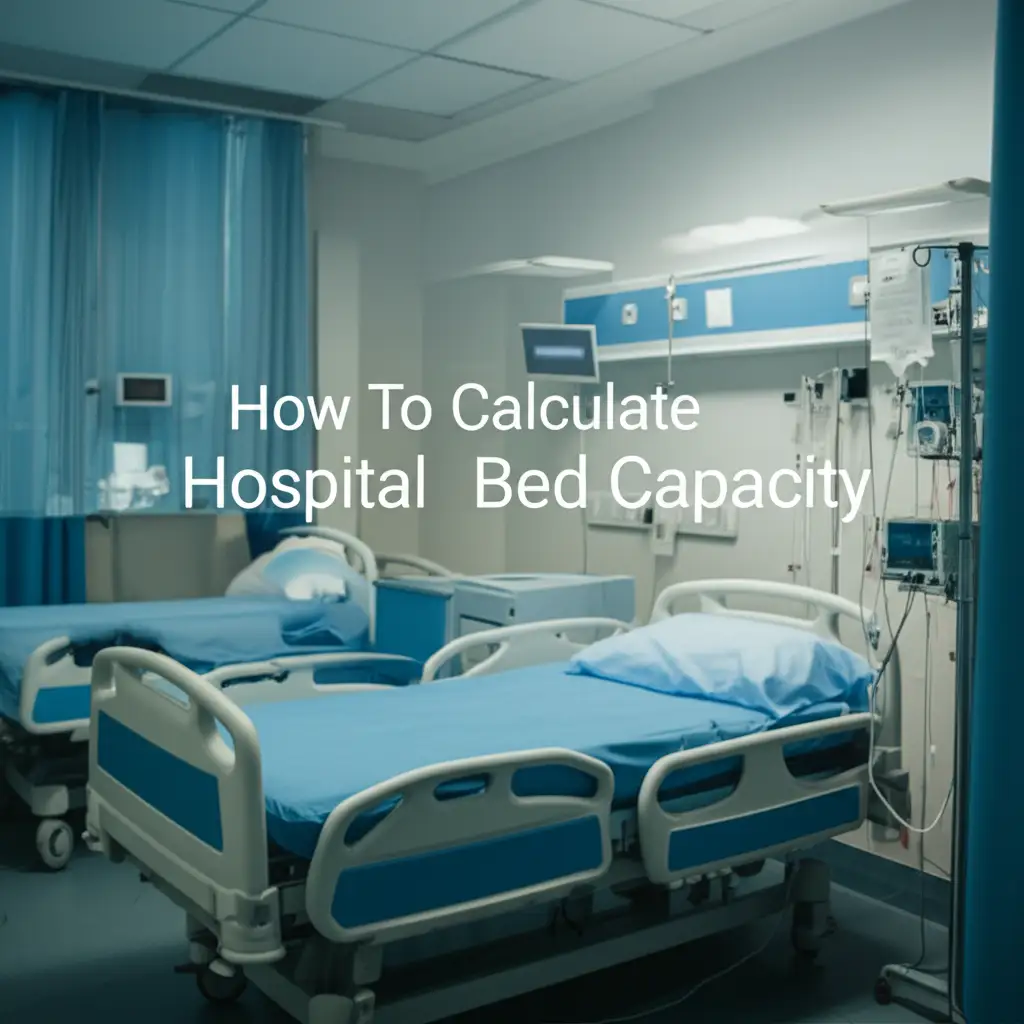· Tessa Winslow · Healthcare Management · 18 min read
How To Calculate Hospital Bed Capacity

Understanding Hospital Bed Capacity Calculation
Have you ever wondered how hospitals manage to care for so many patients? It all starts with understanding their available space. Learning how to calculate hospital bed capacity is a core skill for effective hospital management. This calculation helps healthcare facilities ensure they have enough room for everyone needing care. It also guides their planning for emergencies and daily operations.
In this article, we will explore what hospital bed capacity means. We will look at the key metrics involved in its measurement. We will also discuss the factors that influence it and the different calculation methods. My goal is to give you a clear path to understanding and applying these vital concepts.
Takeaway
- Define Capacity: Understand the difference between licensed, operational, and effective bed capacity.
- Key Metrics: Use occupancy rate, average length of stay, and turnover rate to assess bed use.
- Identify Factors: Recognize how staffing, patient flow, and emergencies impact available beds.
- Apply Formulas: Use simple formulas to measure current and potential bed availability.
- Optimize Use: Implement strategies to improve bed turnover and patient movement.
- Use Technology: Employ software solutions for real-time bed tracking and demand prediction.
To calculate hospital bed capacity, you typically count the number of available, staffed, and equipped beds for patient care. This figure often includes licensed beds, but the operational capacity might be lower due to staffing or equipment limits. Hospitals use this measure to manage patient flow and ensure readiness for demand.
What is Hospital Bed Capacity?
Hospital bed capacity refers to the total number of beds a healthcare facility can use for patient care. This count directly impacts a hospital’s ability to serve its community. It also shows its readiness for various health situations. Understanding this metric is very important for proper planning.
This capacity is not just a simple number. It has different layers of meaning. For example, a hospital might be licensed for 500 beds. However, it may only have staff and equipment for 400 of those beds. This distinction is crucial for daily operations and emergency preparedness.
Licensed vs. Operational Beds
Licensed beds are the maximum number of beds a hospital is legally allowed to operate. State health departments or similar bodies grant these licenses. This number often reflects the physical infrastructure of the hospital. It does not always mean these beds are ready for use.
Operational beds are the beds currently staffed, equipped, and available for patient admission. This number can fluctuate daily based on staff availability, equipment maintenance, and patient demand. Operational capacity is the true measure of a hospital’s immediate ability to admit new patients.
Why Capacity Matters
Accurate bed capacity calculation is vital for several reasons. First, it ensures patient access to care. If a hospital misjudges its capacity, patients might face delays or need transfers. Second, it affects hospital finances. Empty beds cost money, while overcrowded hospitals struggle to provide quality care.
Third, it is key for public health response. During crises like pandemics or natural disasters, understanding available bed capacity helps leaders allocate resources. It also guides decisions about opening temporary care sites. My own experience in observing healthcare operations shows how critical this single metric can be.
Key Metrics for Assessing Bed Utilization
Measuring hospital bed capacity goes beyond a simple count. Hospitals use several key metrics to understand how efficiently they use their beds. These metrics provide insights into patient flow and operational bottlenecks. They help managers make informed decisions.
These measurements give a picture of how busy a hospital is. They also show how quickly patients move through the system. Without these metrics, managing a hospital’s space becomes a guessing game. It is like trying to drive without a speedometer.
Bed Occupancy Rate
The bed occupancy rate shows the percentage of available beds that are currently occupied. Hospitals calculate it by dividing the number of occupied beds by the total number of operational beds. They then multiply this by 100 to get a percentage. For instance, if a hospital has 100 operational beds and 80 are full, the occupancy rate is 80%.
A high occupancy rate can mean a hospital is very busy. It might also suggest a risk of overcrowding. A very low rate could point to underutilization of resources. Finding the right balance is key for efficiency and patient comfort.
Average Length of Stay (ALOS)
Average Length of Stay (ALOS) measures how many days, on average, a patient stays in the hospital. Hospitals calculate it by dividing the total number of patient days by the total number of discharges. For example, if 10 patients stay a total of 50 days, the ALOS is 5 days.
A shorter ALOS usually means more efficient patient care and faster bed turnover. This allows more patients to use the same bed over time. A longer ALOS might indicate slower patient discharge processes or more complex cases. Hospital managers often look for ways to safely reduce ALOS without impacting care quality.
Bed Turnover Rate
The bed turnover rate measures how many times a single bed is used by different patients over a specific period. Hospitals calculate it by dividing the total number of discharges (or admissions) by the average number of operational beds during that period. For example, if a 100-bed hospital has 3,000 discharges in a month, its monthly turnover rate is 30.
A high turnover rate suggests efficient use of beds. It means patients are admitted, treated, and discharged promptly. A low rate might indicate slow patient flow or difficulties in managing discharges. Optimizing this rate helps ensure beds are ready for new admissions.
Discharge Rate
The discharge rate is the number of patients discharged from the hospital within a specific period. This metric reflects the hospital’s ability to move patients out when their treatment is complete. A high and consistent discharge rate helps maintain good patient flow. It frees up beds for new admissions.
This rate is crucial for bed availability. If discharges slow down, beds remain occupied. This creates a bottleneck in the system. Effective discharge planning directly impacts this rate.
Factors Influencing Hospital Bed Availability
Many elements beyond just a raw bed count affect a hospital’s true ability to admit patients. These factors can reduce or increase the effective bed capacity on any given day. Ignoring them can lead to unexpected shortages or inefficiencies. Understanding these influences helps hospitals better manage their resources.
I have seen firsthand how these variables can shift a hospital’s capacity. For example, a sudden flu outbreak can drastically change the number of available beds. Knowing these factors helps hospitals prepare.
Staffing Levels
The number of available beds often depends on having enough staff to care for patients in them. A bed without a nurse, doctor, or support staff is not a functional bed. For instance, if a hospital has 200 beds but only enough nurses for 150 patients, its operational capacity is 150. Staff shortages, especially in nursing, often limit a hospital’s true capacity.
This means that even if a room has a bed, it cannot be used if no one is there to monitor the patient. Hospitals must match their staffing to their desired bed capacity. This ensures patient safety and quality of care.
Equipment Availability
Beyond staff, each bed requires specific medical equipment. This includes monitors, IV poles, oxygen, and specialized tools. A bed might be empty, but if it lacks a needed ventilator, it cannot admit a patient requiring breathing support. Equipment failures or shortages can therefore reduce effective bed capacity.
Regular maintenance checks for equipment are also very important. Ensuring all necessary tools are in working order directly impacts how many beds can serve patients. Thinking about how to keep all hospital equipment ready reminds me of the importance of cleanliness, similar to making sure all patient spaces, like beds, are ready for use. This includes general hygiene and preventing issues. For instance, knowing how to prevent from bed bugs in a hospital setting ensures bed availability and patient safety. Similarly, knowing how long does it take for bed bugs to die if an infestation occurs can inform the downtime for a bed, impacting its availability.
Patient Flow Efficiency
How smoothly patients move through the hospital system greatly impacts bed availability. Delays in admission, transfers, or discharge can tie up beds. For example, if a patient is ready for discharge but waits hours for transport, their bed remains occupied. This prevents new patients from entering.
Efficient patient flow involves:
- Quick Admissions: Streamlined processes to get patients settled fast.
- Timely Transfers: Moving patients between departments without long waits.
- Effective Discharge Planning: Preparing patients for release well in advance.
Optimizing these steps ensures beds become available quickly after a patient leaves. This increases the overall number of patients a hospital can serve over time.
Seasonal Variations and Epidemics
Patient demand often changes with the seasons. Flu season, for example, typically brings a surge in respiratory cases. This increases the need for beds. Other times, like summer, might see fewer admissions for certain conditions. Hospitals must plan for these predictable variations.
Unexpected epidemics or public health crises can cause massive surges in patient numbers. This quickly overwhelms standard bed capacity. During such events, hospitals may activate surge plans, converting non-patient areas or setting up temporary facilities. Effective planning for these surges is critical for community health.
Formulas and Calculation Methods for Hospital Bed Capacity
Calculating hospital bed capacity is more than just counting empty beds. It involves using specific formulas to get a clear picture of available resources. These methods help hospitals understand their current state and plan for future needs. These calculations move from simple counts to more complex readiness measures.
I find that breaking down these formulas makes the overall concept easier to grasp. Each calculation provides a different piece of the puzzle. Together, they create a complete picture of a hospital’s capacity.
Basic Capacity Calculation
The most basic way to determine bed capacity is by counting the physical beds. This gives you the gross bed count.
Gross Bed Count Formula: Gross Bed Count = Total Number of Licensed Beds
This number sets the upper limit based on what the hospital is approved for. However, as discussed, licensed beds do not always equal operational beds.
Operational Capacity Calculation
Operational capacity reflects the actual number of beds ready for use. It considers staffing, equipment, and other practical limitations.
Operational Bed Capacity Formula: Operational Beds = Total Licensed Beds - (Beds Unstaffed + Beds Under Maintenance + Beds Lacking Equipment)
This formula provides a more realistic daily capacity. It helps hospital managers understand how many patients they can truly admit at any given moment.
Effective Bed Capacity
Effective bed capacity considers not just the number of beds but also how efficiently they are used. This often involves looking at patient turnover and average length of stay. It is about how many patients can flow through the beds over a period.
Effective Bed Capacity Calculation (Patients per bed per period): Effective Bed Capacity (per bed) = (Number of Days in Period / Average Length of Stay)
For example, if ALOS is 5 days, one bed can serve 365/5 = 73 patients in a year. Then, Total Effective Bed Capacity = Operational Beds * Effective Bed Capacity (per bed)
This provides a forward-looking measure. It helps estimate how many patients the hospital can manage over a week, month, or year.
Surge Capacity Planning
Surge capacity refers to a hospital’s ability to handle an influx of patients beyond its normal operational limits. This typically happens during emergencies, disasters, or pandemics. It involves activating contingency plans.
Key components of surge capacity often include:
- Convertible Spaces: Transforming non-patient areas (e.g., cafeterias, conference rooms) into patient care zones.
- Staff Redeployment: Shifting staff from less critical areas or bringing in temporary personnel.
- Equipment Mobilization: Accessing emergency stashes of equipment or receiving supplies from external sources.
- Discharge Acceleration: Rapidly discharging stable patients to free up beds.
Calculating potential surge capacity often involves scenario planning. Hospitals estimate how many additional beds they could bring online under extreme circumstances. This preparation is vital for community resilience.
Optimizing Hospital Bed Utilization
After calculating hospital bed capacity, the next step is to use those beds as efficiently as possible. Optimal bed utilization ensures that patients receive timely care and resources are not wasted. It is about making every bed count, every single day. This involves a focus on continuous improvement.
I believe that even small changes in operations can lead to big gains in efficiency. It is all about refining the processes that guide patient movement.
Improving Patient Flow
Smooth patient flow is critical for bed utilization. Any slowdown can cause a domino effect. Hospitals work to reduce wait times at every stage of a patient’s journey.
Strategies include:
- Expedited Admissions: Setting up fast-track admission processes for less severe cases. This prevents delays at the very start of a patient’s hospital stay.
- Efficient Transfers: Creating clear protocols for moving patients between departments or units. This ensures patients get to the right place quickly.
- Proactive Discharge Planning: Starting discharge planning the moment a patient is admitted. This helps ensure patients leave as soon as they are medically ready. This also involves securing post-hospital care options.
These efforts help free up beds more quickly. They make space for new patients needing care.
Reducing Average Length of Stay (ALOS)
A shorter ALOS means a bed becomes available sooner for the next patient. This does not mean rushing patient care. Instead, it means streamlining processes.
Methods to reduce ALOS include:
- Daily Multidisciplinary Rounds: Doctors, nurses, and other care team members meet daily. They discuss each patient’s progress and discharge readiness.
- Clear Treatment Pathways: Developing standardized care plans for common conditions. This helps avoid unnecessary tests or delays.
- Rapid Diagnostic Turnaround: Ensuring lab results and imaging studies are available quickly. This speeds up diagnosis and treatment decisions.
- Robust Post-Acute Care Planning: Arranging for home health, rehabilitation, or skilled nursing facility placement early. This avoids discharge delays.
By optimizing these areas, hospitals can safely reduce how long patients occupy beds. This frees up more capacity.
Leveraging Predictive Analytics
Predictive analytics uses historical data to forecast future patient demand. This helps hospitals anticipate surges or dips in admissions. They can then adjust staffing and bed assignments proactively. For example, if a hospital knows flu cases typically peak in January, it can prepare extra beds and staff.
This kind of foresight allows for better resource allocation. It minimizes the chances of either overstaffing or facing sudden bed shortages. It turns reactive management into proactive planning.
Technology’s Role in Bed Management
Modern technology plays a pivotal role in managing hospital bed capacity efficiently. Automated systems can track beds in real-time, helping staff locate available space quickly. These tools move beyond manual checks, which are often slow and prone to errors. Technology makes bed management smarter and faster.
I have observed how digital solutions transform operations. They take away the guesswork and provide clear data. This allows staff to focus on patient care, not bed hunting.
Real-time Bed Tracking Systems
These systems provide an instant view of every bed’s status. They show which beds are occupied, vacant, or need cleaning. When a patient is discharged, the system immediately marks the bed as needing turnover. Housekeeping can then be dispatched without delay.
Key features often include:
- Digital Status Boards: Displaying bed status for various units.
- Mobile Notifications: Alerting staff when a bed becomes available or needs attention.
- Location Services: Sometimes integrated with RFID tags on beds to pinpoint their exact location.
This real-time visibility minimizes “lost” beds or delays in turnover. It ensures beds are ready for the next patient as soon as possible. Keeping beds clean and ready is important, just like maintaining other items in a home. For example, knowing can I put cat bed in washing machine gives insight into cleaning methods, even if it’s for a different type of bed. Similarly, understanding how to clean various items, like how to clean a ceiling, highlights the general importance of cleanliness in any environment, including a hospital where hygiene is paramount.
Patient Flow Software
Specialized software helps manage the entire patient journey. It tracks patients from admission through discharge. This software identifies bottlenecks in the system. For instance, it can flag if too many patients are waiting for a specific type of bed or diagnostic test.
This type of software can:
- Automate Patient Assignments: Matching patients to the most appropriate available bed based on their medical needs.
- Predict Future Demand: Using algorithms to forecast bed needs based on historical data and current admissions.
- Generate Performance Reports: Showing metrics like ALOS and bed turnover rates over time.
By providing this comprehensive overview, patient flow software helps optimize resource allocation. It also improves overall operational efficiency.
Electronic Health Records (EHR) Integration
Integrating bed management systems with Electronic Health Records (EHR) enhances data accuracy and streamlines processes. When a patient is admitted or discharged in the EHR, the bed status updates automatically. This reduces manual data entry and potential errors.
EHR integration also allows bed management systems to access patient-specific information. This ensures the right patient is placed in the right type of bed. For example, an immunocompromised patient might need a specialized isolation room. This seamless flow of information makes bed assignments more precise and efficient.
Challenges in Managing Hospital Bed Capacity
Managing hospital bed capacity is not without its difficulties. Hospitals constantly face hurdles that can impact their ability to provide care. These challenges range from internal operational issues to external environmental pressures. Addressing them requires ongoing effort and adaptive strategies.
I recognize that these challenges are complex. They often require solutions that combine process changes with technological support. No single answer fits every situation.
Unpredictable Patient Surges
One of the biggest challenges is the unpredictable nature of patient admissions. Hospitals must be ready for sudden increases in demand. These surges can come from various sources. Accidents, local outbreaks, or seasonal illnesses can all cause a rapid influx of patients.
During a surge, beds can fill up faster than they become available. This leads to overcrowding in emergency rooms and delays in admissions. It also strains staff resources. Managing these unpredictable events requires flexible planning and quick decision-making.
Staffing Shortages
Even if a hospital has many physical beds, a lack of staff can render them unusable. Nursing shortages, in particular, are a persistent problem in healthcare. A bed without a dedicated nurse or other essential personnel cannot safely serve a patient. This directly reduces operational capacity.
When staff are stretched thin, patient care quality can suffer. It also increases burnout among healthcare workers. Hospitals must continuously work to recruit, retain, and support their staff. This directly impacts their ability to keep beds open and functional.
Delayed Discharges
Patients are sometimes medically ready to leave the hospital but cannot be discharged immediately. This can happen for several reasons:
- Lack of Post-Acute Care Options: Patients may need placement in a nursing home or rehabilitation facility, and no beds are available.
- Transportation Issues: Patients might lack a ride home or need specialized medical transport.
- Family Delays: Family members may not be ready to pick up the patient or prepare their home.
These delays mean beds remain occupied by patients who no longer require acute hospital care. This creates a bottleneck, preventing new admissions and reducing the effective bed capacity. Hospitals implement discharge planning teams to reduce these delays.
Infrastructure Limitations
Older hospital buildings or those with fixed layouts can also present challenges. They might not have the flexibility to quickly convert spaces or add new beds during a surge. For instance, an older ward might lack the necessary oxygen outlets for every bed. This limits its capacity for certain patients.
Renovations or new construction can address these issues, but they are costly and time-consuming. Hospitals must consider their physical infrastructure when assessing their long-term bed capacity and future expansion plans.
FAQ Section
What is the difference between licensed beds and operational beds?
Licensed beds are the maximum number of beds a hospital is legally approved to have. Operational beds are the actual number of beds currently staffed, equipped, and available for patient care. Operational capacity is usually lower than licensed capacity because of staffing levels, equipment, or maintenance issues.
How does Average Length of Stay (ALOS) affect bed capacity?
Average Length of Stay (ALOS) is the average number of days a patient stays in the hospital. A shorter ALOS means patients leave more quickly, making beds available sooner for new admissions. This increases the hospital’s overall patient throughput and effective bed capacity over time.
What is surge capacity in a hospital?
Surge capacity is a hospital’s ability to handle a sudden, large increase in patients beyond its normal operational limits. This might involve opening temporary beds in non-patient areas, redeploying staff, or mobilizing emergency equipment. It is critical for responding to disasters or public health crises.
Why is patient flow important for bed management?
Efficient patient flow ensures patients move smoothly through the hospital system, from admission to discharge. Delays at any stage can tie up beds, preventing new admissions. Good patient flow minimizes bottlenecks, reduces wait times, and maximizes the number of patients a hospital can serve.
Can technology truly optimize bed capacity?
Yes, technology significantly optimizes bed capacity. Real-time bed tracking systems show available beds instantly. Patient flow software identifies bottlenecks and predicts demand. Integrating these with Electronic Health Records (EHR) streamlines data and automates processes. This leads to more efficient bed utilization and better patient placement.
Conclusion
Understanding how to calculate hospital bed capacity is fundamental for any healthcare facility aiming for efficiency and optimal patient care. We have explored the crucial distinction between licensed and operational beds. We have also examined key metrics like occupancy rate, average length of stay, and turnover rate. These measurements offer a clear picture of a hospital’s ability to serve its community.
Factors such as staffing levels, equipment availability, and patient flow significantly impact this capacity. Hospitals must address these elements to truly understand their capabilities. Leveraging technology, from real-time tracking to predictive analytics, further enhances bed management. While challenges like unpredictable surges and staffing shortages persist, continuous analysis and strategic planning can overcome them. By mastering the calculation and management of hospital bed capacity, healthcare organizations can better prepare for any demand, ensuring timely and effective care for all patients. I encourage you to apply these insights to improve healthcare delivery in your own context.





